#CP System II
Explore tagged Tumblr posts
Text




was happy to get this game with matching numbers to the box on the a+b boards.
#Super Street Fighter II The New Challengers#Capcom#1993#CPS2#CP System II#arcade gaming#arcade game#FGC#fighting games#90s#1990s#90s Arcade Gaming#90s Arcade Game#art#design#arcade#instruction card#arcade arts#retro gaming#video games#mine#personal collection
72 notes
·
View notes
Video
tumblr
X-Men: Children of the Atom (Capcom - CP System II - 1994)
#Now Streaming...#click hyperlink#X-Men#X Men#XMen#Children of the Atom#Capcom#CP System II#fighting games#fighters#Psylocke#zplayz
79 notes
·
View notes
Text
The Free Cheese Episode 568: Super Puzzle Fighter II Turbo
This week on The Free Cheese, give me your garbage and I’ll send it right back! What do you do when your fighting game is the most popular game in the genre? You make a puzzle game spinoff. We play and rank Super Puzzle Fighter II Turbo, while providing some tips that helped us to become incredibly intermediate level players! Reviews Joe I generally love when puzzle games incorporate…
#burning rangers#capcom#cp system ii#gems#puzzle games#street fighter#street fighter ii#super puzzle fighter ii turbo
0 notes
Note
If the Commodore 64 is great, where is the Commodore 65?

It sits in the pile with the rest of history's pre-production computers that never made it. It's been awhile since I went on a Commodore 65 rant...
The successor to the C64 is the C128, arguably the pinnacle of 8-bit computers. It has 3 modes: native C128 mode with 2MHz 8502, backwards compatible C64 mode, and CP/M mode using a 4MHz Z80. Dual video output in 40-column mode with sprites plus a second output in 80-column mode. Feature-rich BASIC, built in ROM monitor, numpad, 128K of RAM, and of course a SID chip. For 1985, it was one of the last hurrahs of 8-bit computing that wasn't meant to be a budget/bargain bin option.
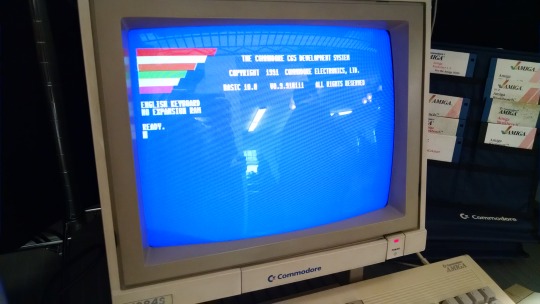
For the Amiga was taking center stage at Commodore -- the 16-bit age is here! And its initial market performance wasn't great, they were having a hard time selling its advanced capabilities. The Amiga platform took time to really build up momentum square in the face of the rising dominance of the IBM PC compatible. And the Amiga lost (don't tell the hardcore Amiga fanboys, they're still in denial).
However, before Commodore went bankrupt in '94, someone planned and designed another successor to the C64. It was supposed to be backwards compatible with C64, while also evolving on that lineage, moving to a CSG 4510 R3 at 3.54MHz (a fancy CMOS 6502 variant based on a subprocessor out of an Amiga serial port card). 128K of RAM (again) supposedly expandable to 1MB, 256X more colors, higher resolution, integrated 3½" floppy not unlike the 1581. Bitplane modes, DAT modes, Blitter modes -- all stuff that at one time was a big deal for rapid graphics operations, but nothing that an Amiga couldn't already do (if you're a C65 expert who isn't mad at me yet, feel free to correct me here).
The problem is that nobody wanted this.
Sure, Apple had released the IIgs in 1986, but that had both the backwards compatibility of an Apple II and a 16-bit 65C816 processor -- not some half-baked 6502 on gas station pills. Plus, by the time the C65 was in heavy development it was 1991. Way too late for the rapidly evolving landscape of the consumer computer market. It would be cancelled later that same year.
I realize that Commodore was also still selling the C64 well into 1994 when they closed up shop, but that was more of a desperation measure to keep cash flowing, even if it was way behind the curve by that point (remember, when the C64 was new it was a powerful, affordable machine for 1982). It was free money on an established product that was cheap to make, whereas the C65 would have been this new and expensive machine to produce and sell that would have been obsolete from the first day it hit store shelves. Never mind the dismal state of Commodore's marketing team post-Tramiel.

Internally, the guy working on the C65 was someone off in the corner who didn't work well with others while 3rd generation Amiga development was underway. The other engineers didn't have much faith in the idea.
The C65 has acquired a hype of "the machine that totally would have saved Commodore, guise!!!!1!11!!!111" -- saved nothing. If you want better what-if's from Commodore, you need to look to the C900 series UNIX machine, or the CLCD. Unlike those machines which only have a handful of surviving examples (like 3 or 4 CLCDs?), the C65 had several hundred, possibly as many as 2000 pre-production units made and sent out to software development houses. However many got out there, no software appears to have surfaced, and only a handful of complete examples of a C65 have entered the hands of collectors. Meaning if you have one, it's probably buggy and you have no software to run on it. Thus, what experience are you recapturing? Vaporware?
The myth of the C65 and what could have been persists nonetheless. I'm aware of 3 modern projects that have tried to take the throne from the Commodore 64, doing many things that sound similar to the Commodore 65.
The Foenix Retro Systems F256K:
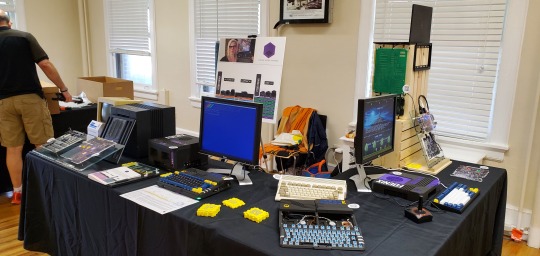
The 8-Bit Guy's Commander X16
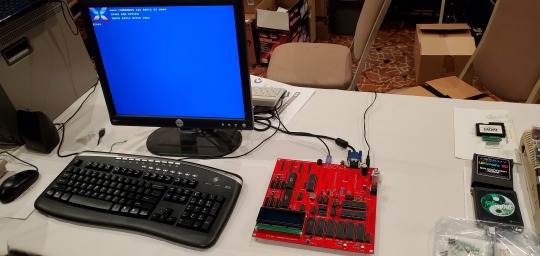
The MEGA65 (not my picture)
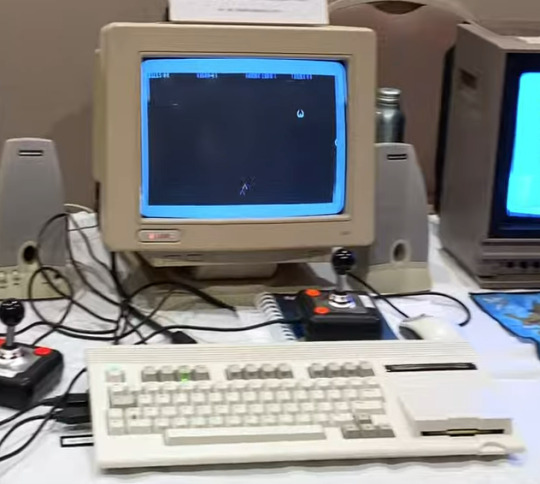
The last of which is an incredibly faithful open-source visual copy of the C65, where as the other projects are one-off's by dedicated individuals (and when referring to the X16, I don't mean David Murray as he's not the one doing the major design work).
I don't mean to belittle the effort people have put forth into such complicated projects, it's just not what I would have built. In 2019, I had the opportunity to meet the 8-Bit Guy and see the early X16 prototype. I didn't really see the appeal, and neither did David see the appeal of my homebrew, the Cactus.
Build your own computer, build a replica computer. I encourage you to build what you want, it can be a rewarding experience. Just remember that the C65 was probably never going to dig Commodore out of the financial hole they had dug for themselves.
262 notes
·
View notes
Text
You may remember my post from a bit ago about a large computer haul, and this is a follow-up of sorts with some new machines I recently got from Ncommander when they were passing through the area.
The first system I want to show is the Kaypro 4. This is my first Z80 machine and my first CP/M machine. I got a boot disk with it, but I'll need to do some work on the floppy drives it looks like - I want to eventually install a Gotek with FlashFloppy.






And for a preview of what the system does when I insert the boot floppy
Next up we have a Pentium system. It's a Pentium 133 and, while I don't know how much RAM it has, it does have a Cirrus Logic video card and some manner of Soundblaster 16 clone it looks like.






And last, but certainly not least, we have a pair of Sun systems - a SPARCstation 5 and an Ultra 1. The SPARCstation 5 has a 70MHz microSPARC-II and 152MB of RAM, meaning it can comfortably run Solaris, one of the BSDs, or (and this is the really cool thing) NeXTstep for SPARC. It also has Sun's CG6 framebuffer installed. The Ultra 1 is a known "cursed" system and sometimes fails to POST. It has a 167MHz UltraSPARC I processor and 64MB of RAM. It doesn't have a framebuffer installed, but it does have two SCSI disks (one bad, one good), and the pair of machines comes with the CG3 that came with the SPARCstation 5 initially.






I plan to get a video made on these acquisitions as soon as I'm able to get my serial cables! I look forward to it. :)
#old tech#retro tech#sun microsystems#unix#old computer#old computers#vintage computers#vintage computer#vintage tech#vintage technology
78 notes
·
View notes
Text
So I did some extensive digging on Sarna, and figured out (roughly) how many WarShips still exist in the non-SLDF navies as of 3152, in canon:
* Lyrans:
LCS Yggdrasil (Mjolnir-class battlecruiser; largest non-SLDF/Clan naval vessel in the Inner Sphere)
LCS Invincible (Tharkad-class battlecruiser; stranded in Tharkad system due to jump drive damage, used as training ship)
* Kuritans:
DCS Draconis Rift (Kyushu-class frigate)
DCS Winds of Heaven (Inazuma-class corvette)
* FedSuns:
FSS Brest (Fox-class corvette; exact status unknown)
FSS Admiral Michael Saille (Fox-class corvette)
* Capellans:
CCS Aleisha Kris (Feng Huang-class)
* FWL:
FWLS Delos (Thera-class carrier)
FWLS Santorini (Thera-class carrier; stranded in Oriente system)
FWLS Menelaus (Agamemnon-class heavy cruiser)
FWLS Galahad (Eagle-class frigate; exact status unknown)
FWLS Lancelot (Eagle-class frigate; exact status unknown)
FWLS Attica (Zechetinu I-class corvette; exact status unknown)
FWLS Haptopoda (Zechetinu II-class corvette; exact status unknown)
* Taurian Concordat:
TCW Vandenburg (Vincent-class corvette; bad case of Kuznetsov Syndrome)
* Calderon Protectorate:
CPS Redemption (Quixote-class frigate)
Just 16 WarShips in the entire Inner Sphere, of which 7 of them are either stranded in one system or have their exact fate unknown as of 3152.
19 notes
·
View notes
Text
Captain Save-A-Hisashi rides again!
I don't know if the comment got eaten by the spam filter; or if it was another case of "did not understand my sense of humour"; or if the blogger has fallen into a black hole on the way to Andromeda, but I did actually save the text, and wanted to post it somewhere, in case anyone ever has any response.
{Comment followed a thread where a random googler had asked for explanation of the Greek letters in Buck-Tick's Nostalgia - Vita Mechanicalis. CP responded to the effect of, don't read too much into it, Imai is not very well educated and the whole thing was just a reference to some Steampunk phone game.}
((Further edited to add: yes, it's entirely possible that this is just a reference to a game, and Delta-Iota-Lambda-Xi refers to nothing more complicated than:
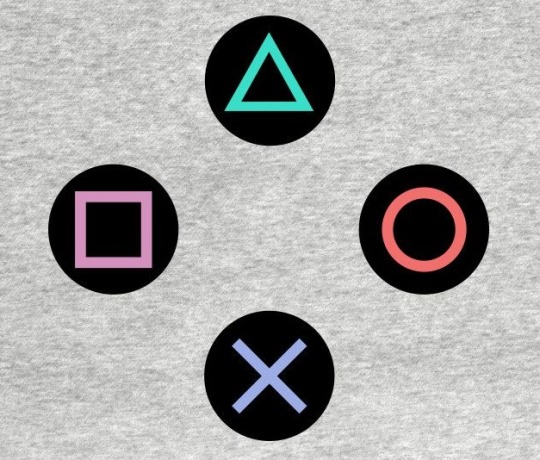
There is indeed both a Delta and a Xi in these characters))
The comment I left in response:
It’s true that Imai is an art school dropout, and his monotropic brain simply cannot hang on to information he doesn’t have an interest in, such as penmanship or random prefectures of Japan. It’s such a SHAME that there is literally no place on Earth or Andromeda where one can come across Greek symbols other than high school maths class!
Chapter 1: amidst the profusion of Imai interviews I’ve absorbed recently, I came across one where our boy mentioned reading James Gleick, so it’s clear he actually does read popular science. (Sorry I can’t footnote it for you, my monotropic brain has never got the hang of footnotes.) Something clicked, as to why the ill-fated tour for Cosmos was named CHAOS: it’s a pun, a synthesis of the “Anarchy” meaning (another long-term preoccupation of Imai, hence the most obvious) and the “complex, self-organising systems” meaning – manifesting in the post-Gleick mid-90s as a pop-science fascination with Fractals. On the chance Imai was fibbing about reading a big book about maths, the ideas popularised by Gleick were widely discussed and heavily used in the fields of Videogame design and Animation – fields Imai has well-known and documented Special Interests in. Knowledge absorbed from pop culture is still knowledge.
Chapter 2: Imai got online in the mid-90s, as documented in his seminal “log off and touch grass” song. What was he arguing about on Usenet? Same things as the rest of us early internet geeks: “Dinosaurs, CT scanners, love, that girl's tooth prints, Klein bottles etc.” Your translation of “いわゆる全てに共通する図形“ is lost, but Google misTranslate is giving me "So-called common-to-all shapes" something that looks suspiciously like set theory or platonic solids? The ~Science Side of Tumblr~. Imai was soaking in it!
Conclusion: living on the net, reading popular science books, imbibing sci-fi, it is not inconceivable that Imai either *does* know the common maths/physics meanings of the Greek symbols he chose; or he lifted them directly from someone who does. (Edited to add: this is the thing; even if he did just lift it from a game; games designers are notorious for adding esoteric references as Easter Eggs. Coming from a game does not mean that it is not meaningful.)
So let’s look at these symbols and see how they link to other common geography of Hisashiland
Δ Delta – this is the easiest one. Delta is the rate of change, usually over time. Everything changes. The only constant over time is change. (The second law of thermodynamics, entropy fans.) ((Edited to add: if I look through my Tumblr archives, I probably can find a long post I made about the relationship between the Second Law of Thermodynamics and Einstuerzende Neubauten's Sehnsucht.))
Ι Iota – the smallest possible amount. How often has Imai referenced scientific words for the concept of the most tiny? Atom Futurist No. 9 (Democritus theorised the Atom – indivisible – as the smallest, infinite, indestructible building block of nature before the Victorians smashed this to pieces with the discovery of the Electron.) Quantum I & II – quantum theory smashed the idea of the smallest building block of nature the way Rutherford smashed the indivisible atom. Iota is another science term for the same thing: the tiny indivisible.
Λ Lambda – the Cosmological Constant. Since the Big Bang, the Universe has been constantly expanding (see section Delta – change!) Lambda is a little mathematical fiddle that Einstein added to the Theory of Relativity to account for the fact that the expansion of the universe is always accelerating. Why? Dark Matter? Dark Energy? This is hotly debated in physics, but in Hisashiland the metaphor of Dark Matter or Dark Energy is repeatedly employed as a necessary corrective for the Blue Sky of conformity.
Ξ Xi – this one was the hardest to crack. At first I thought he’d mis-transliterated the Greek Chi which is the standard mathematical X of the unknown. Xi is the Riemann Function. What’s he about? He’s usually associated with non-Euclidean geometries, surfaces that are impossible outside of multidimensional spaces – moebius strips, Calabi-Yau manifolds (the working model for superstrings, another way of trying to understand where all the extra dark energy/matter is hiding in 10-dimensional space, see Lambda for what Dark Energy means in Hisashiland), and… Klein Bottles, which Imai was getting in flame wars over on the early internet. To understand the true scientific nature of reality, one has to think outside the mosquito net – outside the constraints of the human limitations of three-dimensional perception. In Riemannian maths, dark energy can fold up to hide inside extra dimensions within infinitesimally tiny spaces.
Now these letters may have been chosen stochastically, but all four of them refer to concepts that recur again and again in the hermeneutics of Hisashiland. And one of Gleick’s most profound insights is that randomness isn’t actually that random. Even chaos follows its own cosmological order. Imai may be dirty and strange, but he’s nowhere near as cute-and-dumb as he looks!
#imai mon amour#Nostalgia -Vita Mechanicalis-#things that were in my brain and they are better out of my brain#long post is long
4 notes
·
View notes
Text
How to Prevent Corrosion in Corrugated Steel Water Tanks
1. Corrosion Mechanisms in Water Storage Applications
The electrochemical corrosion process in corrugated steel water tanks primarily involves:
Oxygen differential cells (pH 7-9 range accelerates pitting)
Galvanic corrosion (ΔV > 0.15V between dissimilar metals)
Microbial corrosion (SRB bacteria thrive at >25°C water temperature)
Field observations show corrosion rates vary dramatically:
0.5-1.2 mils/year in temperate climates
3-8 mils/year in coastal regions (ASTM G50 salt spray test data)
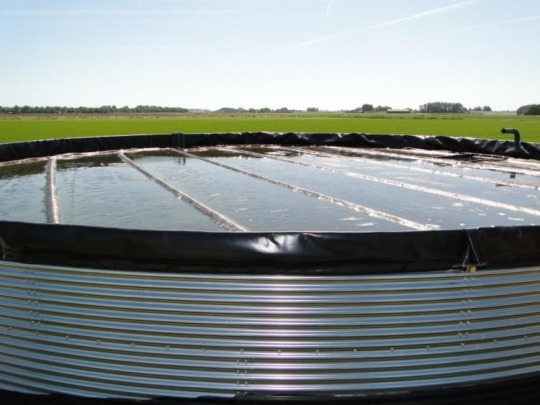
2. Material Selection Standards
Critical specifications for corrosion-resistant steels:
ASTM Coating Standards
StandardCoating TypeMinimum ThicknessService LifeASTM A123Hot-dip galvanizing3.9 oz/ft²25-40 yearsASTM A153Zinc electroplating1.0 mil10-15 yearsASTM A928304L stainless cladding0.06″ overlay50+ years
Note: All thickness values based on 12-year NACE field study data
3. Advanced Coating Technologies
Three-tier protection systems demonstrate best performance:
1. Barrier Coatings
Epoxy-polyamide (DFT 8-12 mils, >5,000 hrs salt spray)
Polyurethane topcoats (UV resistance >20 years)
2. Sacrificial Coatings
85/15 zinc-aluminum thermal spray (per AWS C2.23)
Self-healing micaceous iron oxide (MIO) formulations
3. Hybrid Systems
Example: Galvanizing (ASTM A123) + epoxy intermediate + polyurethane topcoat
4. Cathodic Protection (CP) Systems
Two operational configurations:
Impressed Current CP
Requires 10-100 mA/ft² current density
Titanium mesh anodes (0.3-0.5V output)
90% effectiveness in pH 6.5-9.5 range
Sacrificial Anode CP
Magnesium anodes (ASTM B843 Type II)
1 anode per 30 ft² of submerged surface
Limited to <5,000 μS/cm water conductivity
5. Maintenance & Monitoring Protocols
Essential inspection intervals:
Quarterly:
Ultrasonic thickness testing (UT)
Coating adhesion (ASTM D4541)
Biannual:
CP system voltage verification
Water quality analysis (chloride <250 ppm)
6. Case Studies
Case 1: Agricultural Tank in Texas (Köppen BSh climate)
Problem: 50,000-gallon tank showing 12 mils/year corrosion
Solution: Applied zinc-rich primer + ceramic topcoat
Result: 0.8 mils/year loss after 7 years
Case 2: Municipal Tank in Florida (Coastal Cfa zone)
Challenge: Salt spray corrosion in vapor space
Intervention: Installed dual CP system + MIO coating
Outcome: Extended service life from 15 to 35 years
Comparative Analysis of Protection Methods

0 notes
Text
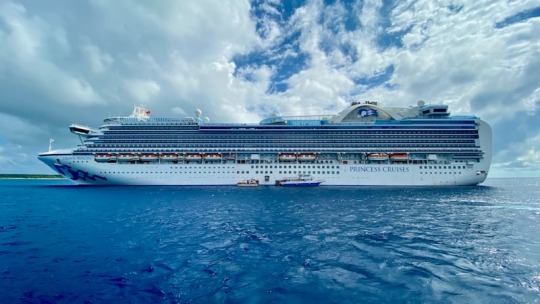
🌊 What I want to do blog: The journey of "Asuka II Cruise" that I want to achieve someday 🚢✨
This time, I would like to write about the cruise journey, one of the "dreams that have not yet been realized" that I have always kept in my heart.
Among them, I particularly admire the Asuka II, a luxury passenger ship that Japan is proud of.
The beautiful hull I saw in the magazine, the sparkling state of the ship on TV...
Each time, I secretly swelled my dream in my heart, saying, "I want to get on this ship someday."
✨ What is the dream cruise "Asuka II"?
"Asuka II" is a luxury passenger ship operated by Nippon Yusen, and it is a famous ship loved by cruise fans at home and abroad.
The hull of about 50,000 tons is perfectly arranged like a city, and the ship has luxurious spaces such as restaurants, lounges, theaters, spas, swimming pools, and libraries.
The most wonderful thing is the concept of "providing a "blissful time" for each person".
Instead of just moving, the ship itself becomes the "purpose of the trip" - I want to experience such a trip just once.
💻 Travel more familiar with My ASUKA CLUB
Asuka II has a membership system called "My ASUKA CLUB".
This is also attractive, and anyone over 2 years old can register even if they have no boarding experience.
On the dedicated site, there are plenty of member-only deals, benefits, point systems, etc., bringing you one step closer to your dream of traveling.
It is also a dream to use "ASUKA CRUISE POINTS (CP)", which is accumulated depending on the number of trips and the type of guest room, and the stage goes up to "silver", "gold" and "platinum".
Isn't this kind of "piling up" trip exciting with a game feeling?
🛳 Cruise schedule of interest (2025-2026)
Now, as for what kind of cruises are actually there, the schedule of Asuka II from October 2025 to March 2026 is all attractive plans.
From short cruises on weekends to long cruises with seasonal events where you can enjoy autumn leaves, Christmas, and New Year's Eve, it's greener.
For example, there is a cruise like this:
• Autumn cruise around Japan (12 days)
From Tohoku, where the autumn leaves are beautiful, to the charming Kansai, and even Kyushu. A long plan that allows you to enjoy the charm of the Japanese archipelago from the sea.
Boarding place: Yokohama Price: 1.12 million yen to 5.45 million yen (for 2 people per room)
• Autumn holiday cruise to and from Kobe (3 days)
3 days of a relaxing weekend. There is also a special stage by singer Hiroko Shimabukuro.
Price: 150,000 yen to 800,000 yen (member discount available)
• New Year Taiwan Cruise from Kobe (10 days)
New Year's Eve countdown with Asuka II! A New Year's cruise where you can enjoy the scenery and food of southern Taiwan.
Price: 760,000 yen to 5.45 million yen (2 people per room)
• Xmas Kochi Cruise to and from Osaka (4 days)
Visit the historic city of Kochi and have a Christmas dinner on board. A seasonal plan that combines travel and events.
Price: 420,000 yen to 1.98 million yen (with member discount)
🍷 What I want to experience on Asuka II Cruise
If I could ride this Asuka II...
First of all, I want to taste coffee while looking at the sea in the morning in a room with a balcony.
When I arrive at the port of call, I want to join a local tour and enjoy local gourmet food, and go back in the evening and look at the horizon of the sunset with champagne in hand.
At night, I pick up one of my favorite books while listening to live piano music in the lounge.
And dinner is a full French course, and you can enjoy the extreme of the extraordinary.
It's so luxurious that just thinking about it makes me sigh, and my heart is enchanted.
🌟 What is the charm of a cruise trip?
The charm of the cruise is the style of "moving = rest".
Traveling by plane or train is inevitably tiring, but on a cruise, you can relax in a luxurious space while traveling.
Also, it is a nice point that you don't have to repack your luggage again and again, and you can reach your next destination while you sleep.
Moreover, hotels, restaurants, and sightseeing are all concentrated on one ship, and the efficiency and comfort are great.
💭 Finally: Cruise is a gift for "my future self"
I haven't ridden Asuka II yet.
But if you think, "Now is the time" at some point in your life --
Without hesitation, I would like to make a reservation and board the ship.
"Not right now, but I want to try it."
Because I have such a dream, I feel like I can do my best every day.
After reading this article, I would be happy if there are people who think, "Cruise is good" or "Asuka II, I might want to ride it".
And someday, if you meet someone who has the same dream at a port somewhere... that may also be the beginning of a wonderful journey.
0 notes
Text

#Street Fighter Zero 2#ストリートファイター Zero 2#1996#Capcom#カプコン#CP System II#CPS2#90s Fighting Games#fighting games#90s Arcade Game#print ad#video game ad#FGC#magazine scan#90s#1990s#Arcade Gaming#Arcade Game#art#design#color#style#retro gaming#video games#graphic design#logo design#logo#Street Fighter Alpha 2#Alpha 2#Zero 2
41 notes
·
View notes
Video
tumblr
Night Warriors: Darkstalkers’ Revenge (Capcom - CP System II - 1995)
#Night Warriors: Darkstalkers’ Revenge#Night Warriors#Darkstalkers' Revenge#darkstalkers#Felicia#Phobos#fighting games#Huitzil#fighters#capcom#CP System II#zplayz#cat girl#cat girls#monster girl#monster girls#robots#mech#robot#bot
27 notes
·
View notes
Text
10 Essential Navy Current Affairs for 2025
The maritime world is witnessing rapid transformation, and 2025 stands at the epicenter of this evolution. Whether it's emerging naval technologies, strategic alliances, or regional security challenges, the current affairs shaping naval forces globally are more critical than ever. For those following navy current affairs 2025 (for TheVeza), this guide highlights the 10 most essential updates making waves this year.

1. Hypersonic Naval Weapons Go Operational
2025 marks a milestone year as multiple countries officially deploy hypersonic weapons on their naval platforms. The U.S. Navy has begun integrating Conventional Prompt Strike (CPS) systems on its Zumwalt-class destroyers, while Russia and China continue to refine their own systems. This technology fundamentally changes naval warfare strategies, offering unparalleled speed and precision.
2. QUAD Naval Exercises Expand Scope
The Quadrilateral Security Dialogue (QUAD) — comprising the U.S., India, Japan, and Australia — has intensified its naval exercises in the Indo-Pacific. In 2025, the Malabar exercises saw the inclusion of advanced anti-submarine drills and joint aircraft carrier operations, sending a clear message of unity and deterrence in contested waters.
3. Climate Security Becomes a Naval Priority
As sea levels rise and extreme weather events grow in frequency, navies worldwide are adapting. 2025 sees the launch of green naval initiatives, such as solar-powered port infrastructure, hybrid propulsion systems, and ocean-cleaning technologies — signaling a shift toward environmental responsibility in maritime strategy.
4. AI-Driven Naval Surveillance Dominates Maritime Intelligence
Artificial intelligence has become central to naval operations in 2025. Advanced AI systems now manage undersea drones, automate threat detection, and analyze vast quantities of satellite imagery in real-time. Nations are racing to develop autonomous fleets capable of patrolling strategic chokepoints without human crews.
5. The South China Sea Heats Up Again
Geopolitical tension remains high in the South China Sea. In 2025, confrontations between Chinese Coast Guard vessels and the Philippine Navy drew international condemnation. Meanwhile, the U.S. Navy increased its freedom of navigation operations (FONOPs), reinforcing international maritime laws and alliances in the region.
6. Cybersecurity Threats Target Naval Infrastructure
This year, multiple navies reported attempted cyberattacks targeting naval command systems, navigation software, and logistics chains. These incidents have prompted unprecedented cooperation on cyber defense strategies between NATO and Indo-Pacific allies, placing cybersecurity on equal footing with kinetic warfare capabilities.
7. New Aircraft Carriers Commissioned
Several major navies welcomed new aircraft carriers in 2025. The U.K.’s HMS Prince of Wales II, equipped with next-gen catapults and drone launch capabilities, became fully operational. Meanwhile, India’s INS Vishal began sea trials, expanding its blue-water operational reach.
8. Women Rise in Naval Leadership
Diversity takes the helm in 2025, with more women in senior naval positions than ever before. Rear Admiral Aisha Rahman of the U.S. Navy made history as the first woman of color to command an aircraft carrier strike group. This trend reflects a broader shift toward inclusion and meritocracy in naval command structures.
9. Arctic Navigation Gains Strategic Importance
As ice caps melt, the Arctic opens up new navigation routes and resource opportunities. Navies, including Canada, Russia, and Norway, have increased patrols and icebreaker deployments to assert territorial claims and secure critical passages, making Arctic strategy a key area of navy current affairs 2025 (for TheVeza).
10. Global Naval Partnerships Strengthen
2025 is the year of naval diplomacy. From joint drills between African coastal navies and NATO fleets to information-sharing pacts in Southeast Asia, the emphasis on global cooperation has grown. Such alliances not only deter aggression but also facilitate humanitarian missions and anti-piracy operations.
Conclusion
The navy current affairs 2025 (for TheVeza) show a world on the brink of maritime reinvention. From technological leaps to renewed geopolitical challenges, navies are evolving rapidly to meet the demands of a changing world. Whether you’re a defense analyst, a maritime enthusiast, or simply a curious reader, keeping an eye on these developments is essential to understanding the global security landscape of tomorrow.
0 notes
Note
What kind of work can be done on a commodore 64 or those other old computers? The tech back then was extremely limited but I keep seeing portable IBMs and such for office guys.
I asked a handful of friends for good examples, and while this isn't an exhaustive list, it should give you a taste.
I'll lean into the Commodore 64 as a baseline for what era to hone in one, let's take a look at 1982 +/-5 years.
A C64 can do home finances, spreadsheets, word processing, some math programming, and all sorts of other other basic productivity work. Games were the big thing you bought a C64 for, but we're not talking about games here -- we're talking about work. I bought one that someone used to write and maintain a local user group newsletter on both a C64C and C128D for years, printing labels and letters with their own home equipment, mailing floppies full of software around, that sorta thing.
IBM PCs eventually became capable of handling computer aided design (CAD) work, along with a bunch of other standard productivity software. The famous AutoCAD was mostly used on this platform, but it began life on S-100 based systems from the 1970s.
Spreadsheets were a really big deal for some platforms. Visicalc was the killer app that the Apple II can credit its initial success with. Many other platforms had clones of Visicalc (and eventually ports) because it was groundbreaking to do that sort of list-based mathematical work so quickly, and so error-free. I can't forget to mention Lotus 1-2-3 on the IBM PC compatibles, a staple of offices for a long time before Microsoft Office dominance.
CP/M machines like Kaypro luggables were an inexpensive way of making a "portable" productivity box, handling some of the lighter tasks mentioned above (as they had no graphics functionality).
The TRS-80 Model 100 was able to do alot of computing (mostly word processing) on nothing but a few AA batteries. They were a staple of field correspondence for newspaper journalists because they had an integrated modem. They're little slabs of computer, but they're awesomely portable, and great for writing on the go. Everyone you hear going nuts over cyberdecks gets that because of the Model 100.
Centurion minicomputers were mostly doing finances and general ledger work for oil companies out of Texas, but were used for all sorts of other comparable work. They were multi-user systems, running several terminals and atleast one printer on one central database. These were not high-performance machines, but entire offices were built around them.
Tandy, Panasonic, Sharp, and other brands of pocket computers were used for things like portable math, credit, loan, etc. calculation for car dealerships. Aircraft calculations, replacing slide rules were one other application available on cassette. These went beyond what a standard pocket calculator could do without a whole lot of extra work.
Even something like the IBM 5340 with an incredibly limited amount of RAM but it could handle tracking a general ledger, accounts receivable, inventory management, storing service orders for your company. Small bank branches uses them because they had peripherals that could handle automatic reading of the magnetic ink used on checks. Boring stuff, but important stuff.
I haven't even mentioned Digital Equipment Corporation, Data General, or a dozen other manufacturers.
I'm curious which portable IBM you were referring to initially.
All of these examples are limited by today's standards, but these were considered standard or even top of the line machines at the time. If you write software to take advantage of the hardware you have, however limited, you can do a surprising amount of work on a computer of that era.
44 notes
·
View notes
Text
#Gamefemerides
Hace 34 años se lanzó Street Fighter II: The World Warrior, también conocido simplemente como Street Fighter II. Es un juego de peleas competitivo desarrollado por Capcom, originalmente para Arcades. Es la 2da entrega de la serie Street Fighter, secuela del original de 1987. Es el 14to título en usar el CP System arcade board. SFII mejoró muchos de los conceptos introducidos en el primer juego, incluyendo el uso de movimientos especiales basados en comandos y una configuración de 6 botones, ofreciendo a los jugadores una mayor selección de personajes jugables, cada uno con su propio estilo de pelea e introduciendo el sistema de combos.
#LegionGamerRD #ElGamingnosune #Videojuegos #Gaming #RetroGaming #RetroGamer #CulturaGaming #CulturaGamer #GamingHistory #HistoriaGaming #GamerDominicano #GamingPodcast #Podcast #Capcom #StreetFighter #StreetFighterII #Arcade #Nintendo #SNES #NintendoSwitch #PlayStation #PS2 #PS3 #PS4 #Microsoft #Xbox #Xbox360 #XboxOne #Peleas
instagram
1 note
·
View note
Photo
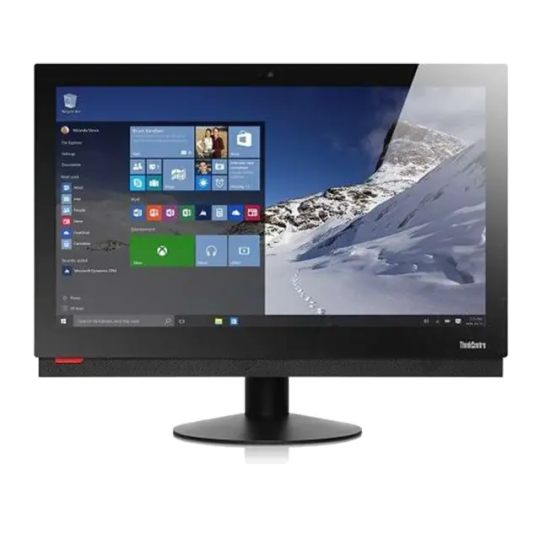
Lenovo ThinkCentre M900z Intel Core i5 6th Gen Stylish. Rugged. Perfect for the Office. The all new M900z AIO comes in a sleek new design that impresses and saves space with its thinner frame. And having passed US military spec testing, it's more rugged than ever. The M900z guarantees powerful performance. Purposefully designed with combined DP in and CP out into one single port you can conveniently switch between laptop, AIO and extended monitor. With other features such as integrated handle for mobility and wide viewing angle, the M900z is an ideal solution for enterprise productivity. Specifications Chassis / Form Factor All-in-one Display / Diagonal Size 23.8 in Display / Diagonal Size (metric) 60.45 cm Display / Native Resolution 1920 x 1080 Display / Type LED Display / Widescreen Display Yes Processor / Chipset Chipset Type: Intel Q170 Clock Speed: 3.2 GHz CPU: Intel Core i5 (6th Gen) 6500 CPU Socket LGA1151 Socket Max Turbo Speed 3.6 GHz Number of Cores Quad-Core Processor Main Features Intel Turbo Boost Technology 2 RAM Configuration Features 8 GB RAM Effective Memory Speed 2133 MHz Features Dual channel memory architecture Form Factor SO-DIMM 260-pin Max: 32 GB Slots 2 (total) / 1 (empty) Technology DDR4 SDRAM Storage Controller Controller Interface Type SATA 6Gb/s Type 1 x SATA Hard Drive / Capacity 500 GB Hard Drive / Interface Serial ATA-600 Networking / Data Link Protocol Bluetooth 4.1 Fast Ethernet Gigabit Ethernet IEEE 802.11a IEEE 802.11ac IEEE 802.11b IEEE 802.11g IEEE 802.11n Networking / Wireless LAN Supported Yes Networking / Wireless Protocol 802.11a/b/g/n/ac Bluetooth 4.1 Optical Storage Optical Storage Type: DVD-Writer Video Output Graphics Processor Intel HD Graphics 530 Audio Output Compliant Standards High-Definition Audio Sound Output Mode Stereo Speakers Included 2 x right / left channel Camera Camera Yes Features Built-in 2 microphones Resolution 1080p Card Reader Type 9 in 1 card reader Expansion / Connectivity Interfaces 6 x USB 3.0 (2 front, 4 rear) 1 x headphones/microphone (1 in front) 1 x DisplayPort input/output combo 1 x LAN (Gigabit Ethernet) General Built-in Devices Stereo speakers Color Business black Embedded Security Trusted Platform Module (TPM 1.2) Security Chip Localization Language: English Platform Technology Intel vPro Platform Product Form Factor All-in-one - with UltraFlex II Stand Graphics Controller Graphics Processor Intel HD Graphics 530 Video Interfaces DisplayPort Input Device Keyboard Interface USB Keyboard Name Preferred Pro USB Localization & Layout US Mouse Interface USB Technology Optical Operating System / Software OS Not provided: Windows 10 Pro 64-bit Edition Power Device Type Power supply Efficiency 85% Power Provided 150 Watt Voltage Required AC 120/230 V (50/60 Hz) No operating system installed
0 notes
Text

Long post! Beware!
Well, let me tell you the story the most important piece of software that nobody really knows about. The Basic Input Output System is a piece of software that comes bundled with the hardware. The first ones were burned [1] into Read Only Memory chips. At boot, the CPU has a specific memory address that it just starts running. The BIOS is that program that it runs.
Basically, as the name suggests, it’s a fairly simple program and it sets up the bridge between the OS and the hardware. Meaning that it sets up the equivalent of a mailbox for all the things to communicate with each other.
This means that you can write a single Operating System and so long as it can speak BIOS, it can run on the dozens of Intel 8080 computers on the market in the early 80s.
Which brings us to the author: Gary Kildall. Gary wrote BIOS for his product CP/M (Control Program for Microcomputers - a term that made sense at the time). CP/M was an OS for the growing home computer market. Computers like the Commodore 64, Apple II, even the first home computer the Altair 88 all booted into BASIC which was a simple programming language. But all these versions were different. If you booted into a program that only dealt with managing files (these didn’t even have directories aka folders ) and launching programs, it would be a lot easier.[2]
For this reason, IBM wanted to buy CP/M. They approached Microsoft as the broker for the deal and for … reasons [3] … they ended up hiring MS to write a clone of it instead. This became PC DOS [4] and the reason Bill Gates was the richest man in the world for a long time.
The BIOS was the thing that stood between the hardware and the software. So if anyone wanted to run DOS on a generic PC clone, they would need a BIOS for that clone. But software is copyrighted, so the few companies that just copied the available code from IBM got sued into oblivion. Until a plucky company called Compaq came up with the “clean room” method. 1 team would read the code and write what it does and a second team would write fresh code based on those specs. This was upheld in court when Big Blue tried to take them down.
At the time IBM and Apple controlled their hardware ecosystem and set the price of access to computing. But freeing the BIOS turned the technology inferior intel based PC into an open platform, which lead to cheaper competitors and the reason that the PC is so dominant.
Modern computers have replaced the BIOS with the Extended Firmware Interface (EFI). People still call it BIOS because few understand what it ever did, but BIOS is dead. Long live BIOS
Footnotes:
[1] Programmable ROM chips are a grid diodes, which let current run in one direction. If you apply enough heat, it will literally burn out the diode so current can’t run in any direction. Apply test voltage on an unburned bit you get that voltage back, a 1. Otherwise the current is blocked and you get a 0. Flash Memory is a distant ancestor of this technology.
[2] remember that this was all done before the home computers could display graphics without dipping into the machine language (Assembly Language- which is different for every type of processor). Thus you typed lines of commands as your interface, a Command Line Interface.
[3] obviously the reasons vary depending on the storyteller, for some Kildall was hardheaded and wanted to retain ownership, for others, there was a miscommunication.
[4] the deal allowed MS to sell their own version of it, MS DOS. This will come up in a sec.
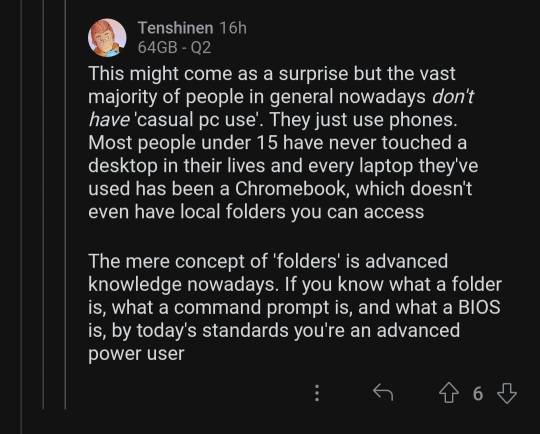
this can't be true can it
99K notes
·
View notes